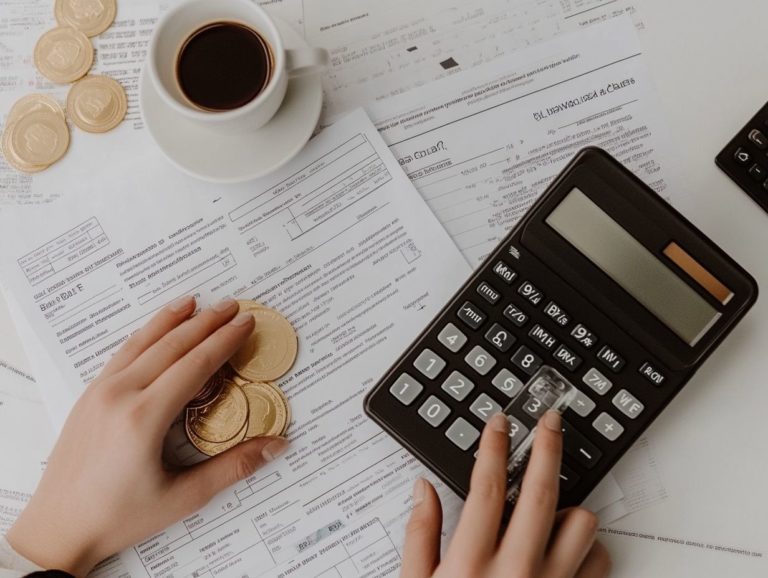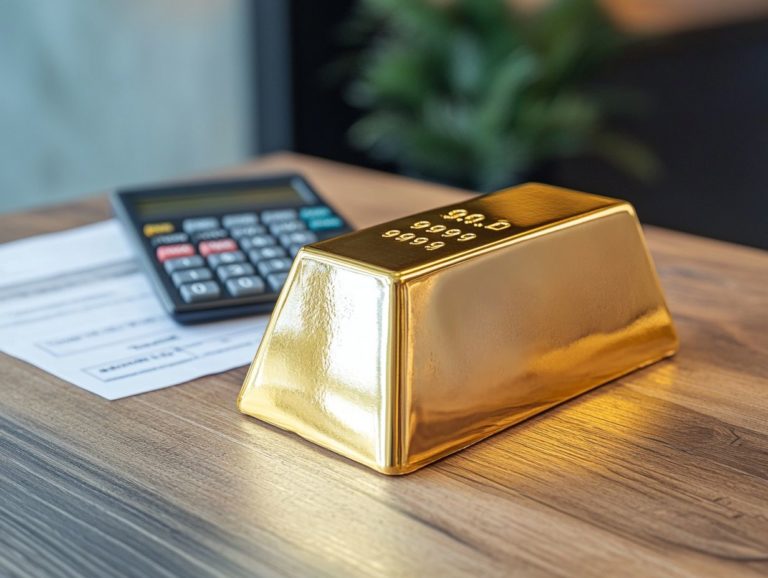How to Report Precious Metals on Your Tax Return
Investing in precious metals can be a savvy financial decision. However, it comes with its own set of tax obligations that you need to grasp fully.
Understanding the distinctions between gold, silver, and other valuable metals is just the beginning. Mastering the nuances of how to report these assets on your tax return can be quite the challenge.
This guide simplifies the essential aspects of taxes related to precious metals. It includes the implications of buying and selling while also offering strategies to maximize your tax benefits.
Whether you’re a seasoned investor or just beginning your journey, this information will keep you informed and compliant. It ensures you make the most out of your investments.
Contents
- Key Takeaways:
- Understanding Precious Metals and Taxes
- Types of Precious Metals
- Reporting Precious Metals on Your Tax Return
- Tax Implications of Buying and Selling Precious Metals
- Tax Strategies for Precious Metal Investors
- Frequently Asked Questions
- How do I report precious metals on my tax return?
- What forms do I need to report precious metals on my tax return?
- Do I have to pay taxes on my precious metal investments?
- What if I have a loss on my precious metal investment?
- Can I use an IRA to invest in precious metals?
- What happens if I don’t report my precious metal investments on my tax return?
Key Takeaways:

- Precious metals are considered investments and must be reported on tax returns.
- Gold, silver, and other metals may be taxed differently and require separate reporting on tax forms.
- Investors should be aware of capital gains and losses when buying and selling precious metals. You can utilize tax strategies to maximize benefits and minimize liabilities.
Understanding Precious Metals and Taxes
Understanding the intricate relationship between precious metals and taxes is essential for any investor. It is key for navigating the complexities of capital gains and other tax implications.
Precious metals like gold and silver serve not just as a hedge against inflation but also as a significant store of wealth. However, the Internal Revenue Service (IRS) considers these assets collectibles, which can profoundly influence your investment strategies, especially regarding tax considerations for importing precious metals.
This guide will explore how to report these assets. It clarifies the obligations that accompany ownership, including the necessary forms and requirements for compliance with the IRS.
Overview of Tax Obligations for Precious Metal Owners
As a precious metal owner, you absolutely need to understand your tax obligations. These rules can significantly influence your investment decisions.
It’s essential to accurately report profits or losses on Form 1099-B and reflect any capital gains on Form 1040. The ownership and sale of metals such as gold, silver, and platinum come with unique implications that you must grasp to maintain compliance, especially regarding how to prepare for changes in precious metals tax laws.
Capital gains are the profits you earn from selling your precious metals for more than you paid. These taxes can greatly affect the overall profitability of your investments. Therefore, it’s imperative to keep meticulous records of each transaction.
Filing accurate tax returns is important because it ensures that you adhere to regulations. It also helps you avoid potential audits or penalties from simple oversights.
Types of Precious Metals
When you think of precious metals, gold and silver undoubtedly top the list. Each presents its own distinct advantages and value in their physical forms.
These metals are frequently minted into iconic coinage, such as the American Gold Eagle and the Canadian Gold Maple Leaf. These coins play a significant role in shaping their market value.
Differentiating Between Gold, Silver, and Other Metals

Differentiating between gold, silver, and other precious metals is essential for you as an investor. It helps you maximize your portfolio’s market value and select the right investment vehicle.
Each metal has its own unique characteristics and market dynamics that directly impact its investment potential. For example, while gold is often considered a safe haven during economic uncertainty, its relatively high price might put it out of reach for some investors.
On the other hand, silver often dubbed the “poor man’s gold” offers a lower entry cost. However, it comes with its own set of challenges, including volatility and industrial demand that can lead to significant price swings.
Then there are other precious metals like platinum and palladium. These diversify your options further by appealing to niche markets, primarily influenced by automotive and technological advancements.
As an investor, it s crucial for you to weigh these attributes against market trends. This will help you make well-informed decisions about asset allocation.
For more detailed guidance, consider consulting a tax professional or exploring additional resources to enhance your knowledge.
Reporting Precious Metals on Your Tax Return
Accurate reporting of precious metals on your tax return is essential for maintaining compliance with the IRS. Make sure all forms and schedules, including Form 1099-B and Form 1040, are carefully filled out.
This attention to detail safeguards you against potential audits and upholds your financial integrity.
Forms and Schedules to Use
When reporting precious metals, it s crucial to use the correct forms and schedules, particularly Form 1099-B and Form 1040, to meet IRS standards.
These forms are designed to ensure that your transactions are documented accurately, capturing both gains and losses from your precious metal sales.
To complete these forms properly, include essential details such as the date of acquisition, the selling price, and any associated costs. This information is vital for compliance and precise tax reporting. Neglecting these requirements could lead to audits or penalties.
By understanding the importance of each form, you can navigate your obligations more effectively and optimize your financial outcomes in line with IRS regulations.
Tax Implications of Buying and Selling Precious Metals
Understanding the tax implications of buying and selling precious metals is essential for any investor. These transactions can result in substantial profits, ultimately influencing your overall tax liability.
Being informed allows you to navigate the complexities of these investments with confidence and clarity.
Capital Gains and Losses

Profits and losses from the sale of precious metals should be a priority for you as an investor, given the specific tax implications outlined by IRS regulations.
When you decide to sell your precious metals, whether it’s gold, silver, or platinum, it’s essential to calculate your profits or losses to fully grasp the tax consequences. Additionally, understanding how to prepare for potential tax changes in precious metals can help you navigate any financial implications effectively.
The IRS categorizes these profits into two types: short-term and long-term, based on how long you’ve held the asset. Short-term gains apply to precious metals held for one year or less and are taxed as ordinary income. In contrast, long-term gains, applicable to assets held beyond that timeframe, benefit from lower tax rates. It’s important to be aware of the tax consequences of trading precious metals to make informed investment decisions.
Understanding these distinctions allows you to make informed decisions that maximize your returns and minimize your overall tax liabilities.
Tax Strategies for Precious Metal Investors
By adopting effective tax strategies, you can significantly influence your investments in precious metals. Smart tax strategies can boost your benefits and lower your tax bills!
Maximizing Tax Benefits and Minimizing Liabilities
To achieve maximum tax benefits and minimal liabilities as a precious metal investor, make informed investment decisions that align with IRS guidelines.
This means choosing the right types of precious metals, like bullion or coins, which offer distinct tax advantages.
For instance, gold bullion is generally taxed as collectible property, with a capital gains tax rate that can reach up to 28%. Conversely, investing in precious metal IRAs can defer or even eliminate taxes on gains until you make a withdrawal.
Stay updated on regulations to ensure that your precious metals are stored in approved depositories, keeping you compliant with IRS requirements.
Employing strategies like tax-loss harvesting selling off losing investments to offset gains and reduce tax liability can enhance your tax efficiency.
Frequently Asked Questions
Don’t wait to optimize your tax strategies; start today to maximize your returns! For personalized guidance, consult a tax professional.
How do I report precious metals on my tax return?

To report precious metals on your tax return, fill out the appropriate tax forms. Include details like the type of metal, quantity, purchase date, price, and any gains or losses.
What forms do I need to report precious metals on my tax return?
The most common form is Form 8949, which reports capital gains and losses. You may need to fill out Form 1099-B if you received a 1099 from the dealer or broker.
Do I have to pay taxes on my precious metal investments?
Yes, you may owe taxes on your precious metal investments. The tax type depends on the metal and how long you held it.
Precious metals held for less than a year are short-term capital gains, taxed at your regular income rate. Metals kept for more than a year are long-term capital gains, taxed at a lower rate.
What if I have a loss on my precious metal investment?
If you have a loss, you might deduct it from your taxes. This capital loss can offset any capital gains from other investments.
If your capital losses exceed your gains, you can deduct up to $3,000 of the remaining losses against your regular income.
Can I use an IRA to invest in precious metals?
Yes, a self-directed IRA allows you to invest in precious metals. This IRA lets you invest in alternative assets, including precious metals, real estate, and private equity.
However, specific rules and regulations must be followed to ensure your investments are tax-deferred.
What happens if I don’t report my precious metal investments on my tax return?
Failing to report your precious metal investments could lead to penalties, so it s crucial to stay on top of your taxes! It’s important to accurately report all your investments, including precious metals, to avoid legal consequences.
Consult a tax professional if you re unsure how to report your investments.














